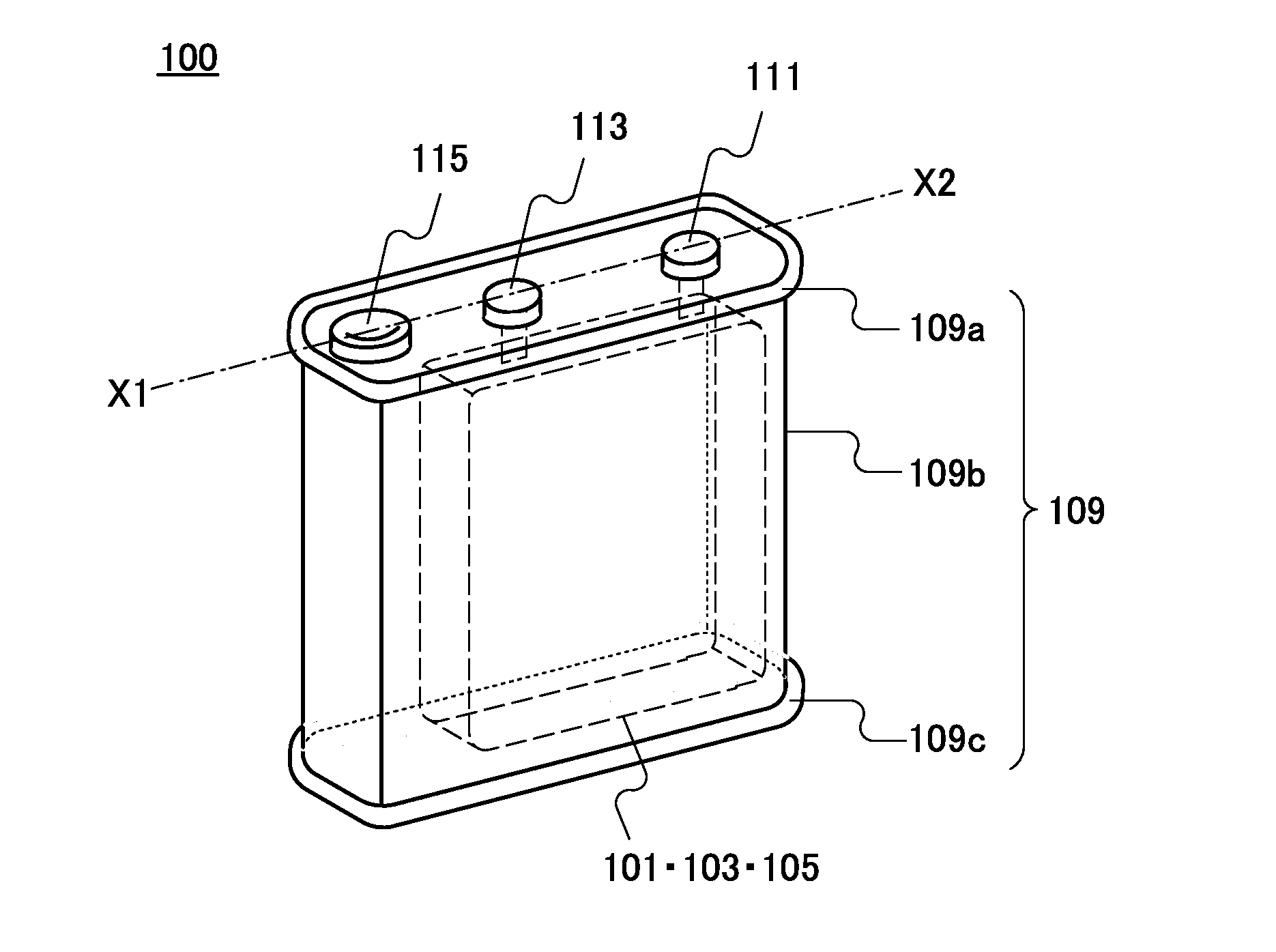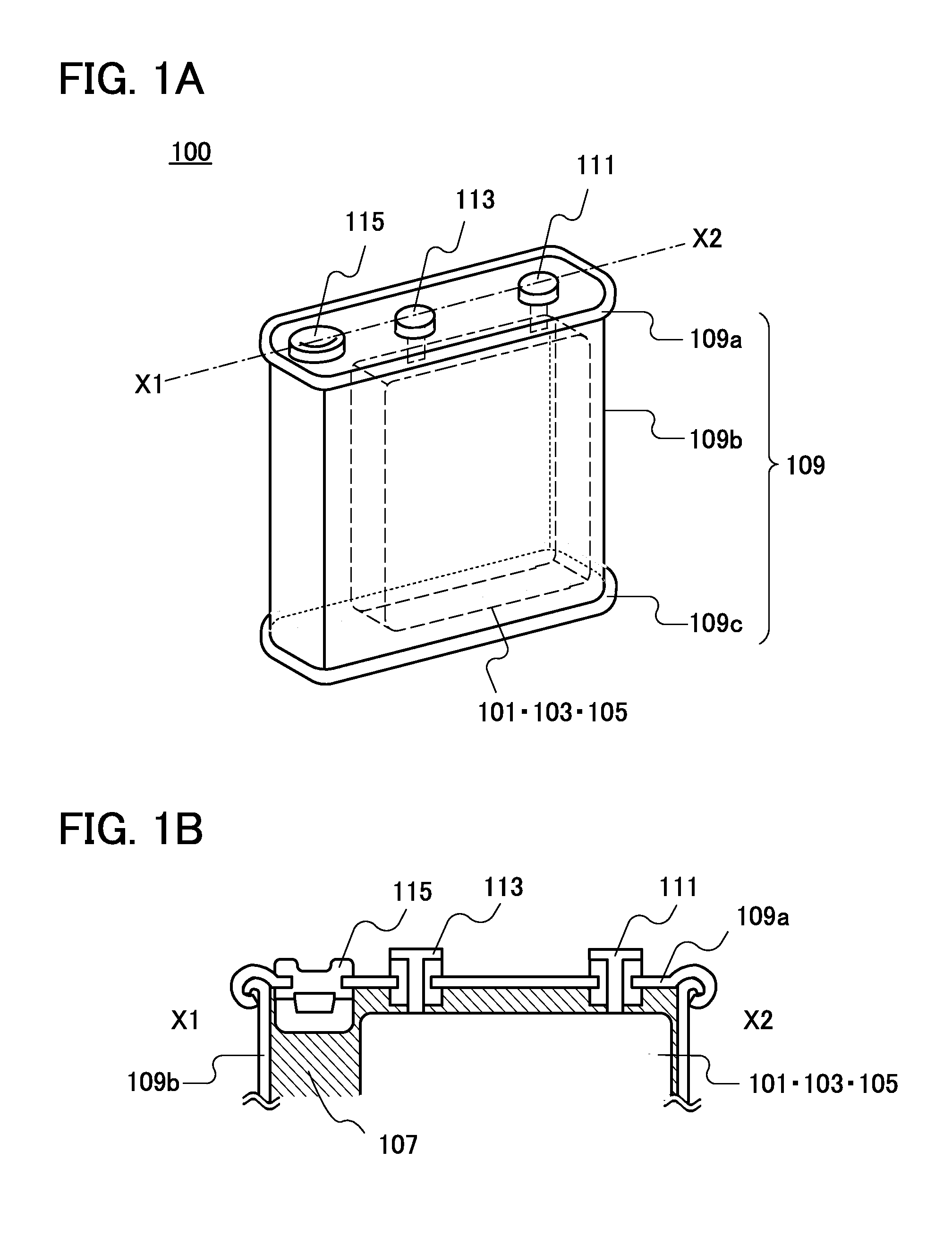Secondary battery and method for restoring capacity of secondary battery
a secondary battery and capacity restoration technology, applied in the field of secondary batteries, can solve the problems of increasing the cost of maintenance, affecting the performance of secondary batteries, and affecting the service life of secondary batteries, so as to improve the service life and the capacity of secondary batteries, and improve the service life. the effect of the battery reaction
- Summary
- Abstract
- Description
- Claims
- Application Information
AI Technical Summary
Benefits of technology
Problems solved by technology
Method used
Image
Examples
embodiment 1
[0042]In this embodiment, an example of a nonaqueous secondary battery of one embodiment of the present invention is described with reference to FIGS. 1A and 1B, FIGS. 2A to 2C, FIGS. 3A to 3D, FIGS. 4A to 4E, FIGS. 5A to 5G, and FIGS. 6A and 6B.
[0043]First, an example of an exterior body of a secondary battery of one embodiment of the present invention is mainly described with reference to FIGS. 1A and 1B. FIG. 1A is a perspective view of a secondary battery 100. FIG. 1B shows a part of a cross-sectional structure taken along dashed-dotted line X1-X2 in FIG. 1A. The secondary battery 100 includes a positive electrode 101, a negative electrode 105, a separator 103 between the positive electrode 101 and the negative electrode 105, and an electrolyte solution 107. The secondary battery 100 further includes an exterior body 109 covering the positive electrode 101, the negative electrode 105, the separator 103, and the electrolyte solution 107. In FIGS. 1A and 1B, the positive electrode...
embodiment 2
[0084]In this embodiment, examples of components including the positive electrode 101, the negative electrode 105, the electrolyte solution 107, and the separator 103 of the nonaqueous secondary battery 100 of one embodiment of the present invention are described.
[0085]First, the positive electrode 101 is described.
[0086]The positive electrode 101 includes a positive electrode current collector and a positive electrode active material layer formed over the positive electrode current collector by a coating method, a CVD method, a sputtering method, or the like, for example.
[0087]The positive electrode current collector can be formed using a material that has high conductivity and is not alloyed with lithium, such as a metal typified by stainless steel, gold, platinum, zinc, iron, copper, aluminum, or titanium, or an alloy thereof. Alternatively, an aluminum alloy to which an element which improves heat resistance, such as silicon, titanium, neodymium, scandium, or molybdenum, is adde...
embodiment 3
[0133]The secondary battery of one embodiment of the present invention can be used as a power source and a power storage device for a variety of electrical devices. The electrical devices may each include a secondary battery or may be connected wirelessly or with a wiring to one or more secondary batteries and a control device controlling power systems of these devices to form a power system network (electric power network). The electric power network controlled by the control device can improve usage efficiency of electric power in the whole network.
[0134]FIG. 7 illustrates an example of a home energy management system (HEMS) in which a plurality of home appliances, a control device, a secondary battery, and the like are connected in a house. Such a system makes it possible to check easily the power consumption of the whole house. In addition, the plurality of home appliances can be operated with a remote control. Further, automatic control of the home appliances with a sensor or t...
PUM
| Property | Measurement | Unit |
|---|---|---|
| Shape | aaaaa | aaaaa |
| Depth | aaaaa | aaaaa |
Abstract
Description
Claims
Application Information
 Login to View More
Login to View More - R&D
- Intellectual Property
- Life Sciences
- Materials
- Tech Scout
- Unparalleled Data Quality
- Higher Quality Content
- 60% Fewer Hallucinations
Browse by: Latest US Patents, China's latest patents, Technical Efficacy Thesaurus, Application Domain, Technology Topic, Popular Technical Reports.
© 2025 PatSnap. All rights reserved.Legal|Privacy policy|Modern Slavery Act Transparency Statement|Sitemap|About US| Contact US: help@patsnap.com



